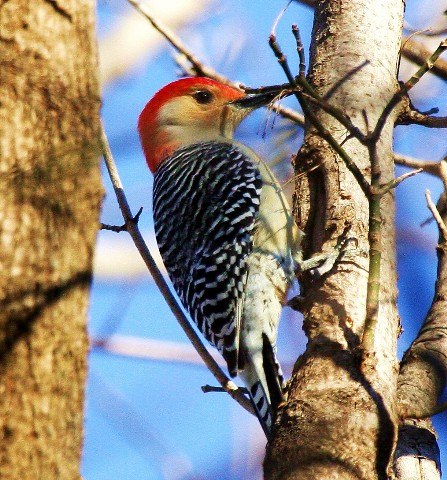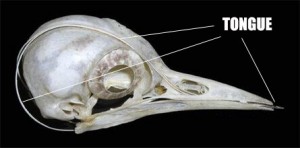A Red-Bellied Woopecker’s Tongue is Almost Three Times the Length of Its Beak and Wraps Around Its Skull When Retracted
 Today I found out that the tongue on a Red-Bellied woodpecker, along with some other species of woodpecker, is so long that it can extend at least three times the bill length and, when retracted, wraps around its skull.
Today I found out that the tongue on a Red-Bellied woodpecker, along with some other species of woodpecker, is so long that it can extend at least three times the bill length and, when retracted, wraps around its skull.
According to a study conducted by the Dalian University of Technology in China, Grey-Faced woodpeckers have a tongue that measures around 171mm (6.73 inches), which is about 2.8 times the length of their beaks (~60mm or 2.36 inches) and typically even longer than their body length (~165mm or 6.5 inches, measured from the mouth tip to the buttock).
In this species of woodpecker, and some others, the tongue is so long that it forks in the throat, goes below the base of the jaw and wraps behind and over the top of the head, where the forked section rejoins and inserts in the bird’s right nostril or around the eye socket.
This bizarre tongue structure is possible because of a linear series of tiny bones sheathed in muscles and soft tissue known as “hyoid apparatus” that extends the entire length of the woodpecker’s tongue. This cartilage-bone like skeleton of its tongue is sheathed in muscle and soft tissue and the ultra-thin hyoid bones fold up like an accordion when not outstretched. Contraction of the muscles pulls the tips of the hyoid bone around the back of the head and back down toward the mouth, and in doing so, pushes the tongue out the mouth.
So what does our small feathered friend do with the talented tongue? After he has slammed his head against a piece of dead wood, or tree at the rate of around 15 miles per hour, repeatedly and several times over, (see bonus factoids as to why the little guy doesn’t get brain damage), he shoves his elongated tongue deep into the hole, searching for small bugs or insects. He’ll feel around the insects thin tunnels, and, when he finds one, he pierces it with his tongue , which is covered in sharp barbs like a spear, and then pulls it back in for eating. The woodpecker’s tongue also contains paired longitudinal muscles that allow it to move side to side as the bird probes for food. A woodpecker’s tongue is especially sensitive to touch, an adaptation that aids in detecting unseen insects within dead wood.
 Not all species of woodpeckers have barbed tongues or feeding behaviors like that of the Red-bellied woodpecker. Take for example the Yellow-bellied Woodpecker {A.K.A. Sapsucker}. It burrows 1/4 inch holes and uses it’s tongue to lap up the sap, not unlike a hummingbirds tongue (except a hummingbird’s tongue is split and rolls into a shallow spoon like shape). Oddly enough though, a baby woodpecker’s tongue is actually quite short, making it much easier for a parent bird to stick food items into their hungry little mouths.
Not all species of woodpeckers have barbed tongues or feeding behaviors like that of the Red-bellied woodpecker. Take for example the Yellow-bellied Woodpecker {A.K.A. Sapsucker}. It burrows 1/4 inch holes and uses it’s tongue to lap up the sap, not unlike a hummingbirds tongue (except a hummingbird’s tongue is split and rolls into a shallow spoon like shape). Oddly enough though, a baby woodpecker’s tongue is actually quite short, making it much easier for a parent bird to stick food items into their hungry little mouths.
Bonus Facts:
- A woodpeckers brain is protected by a spongy elastic material between their bill and their skull that holds their brain so tight that it can’t move around, which is what keeps it from getting injured while they bang away at at tree, which produced incredible G-forces.
- Woodpeckers have small feathers over their nostrils that help keep wood particles from being inhaled.
- A pair of stiff, centrally placed tail feathers allow the woodpecker to “tripod” itself on trees. This allows them to peck away at a tree, or whatever surface, for long periods of time without getting tired from holding themselves on the side of the tree. These particular tail feathers are not molted until their replacement feathers have already grown in.
- Downy woodpeckers are the most common backyard woodpecker. Pileated woodpeckers are almost as big as American crows, making them the largest member of the woodpecker family.
Expand for References:
| Share the Knowledge! |
|





This was so interesting, I was taking a picture of a young red bellied woodpecker today at the suet feeder. I noticed his tongue come out to eat, the first time I’ve ever witnessed it. Glad to know more about one of my favorite visitors.
I have been watching red bellied woodpeckers at my feeder and suet for several years now and today was the 1st time I saw her tongue. 3/19/2020. My woodpeckers love dog food and will call when I am outside waiting for the food. They used to steal my dogs food & now regularly look for it so I started adding dog food in with the bird seed.